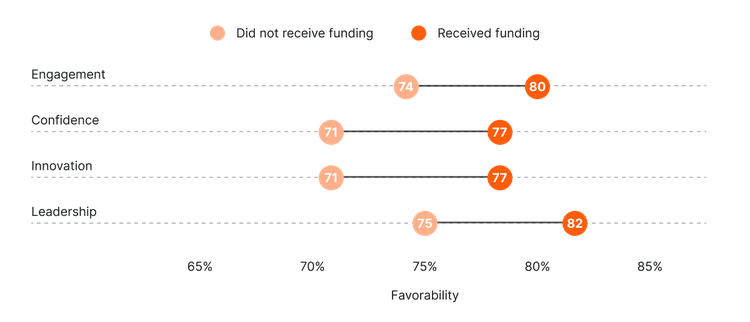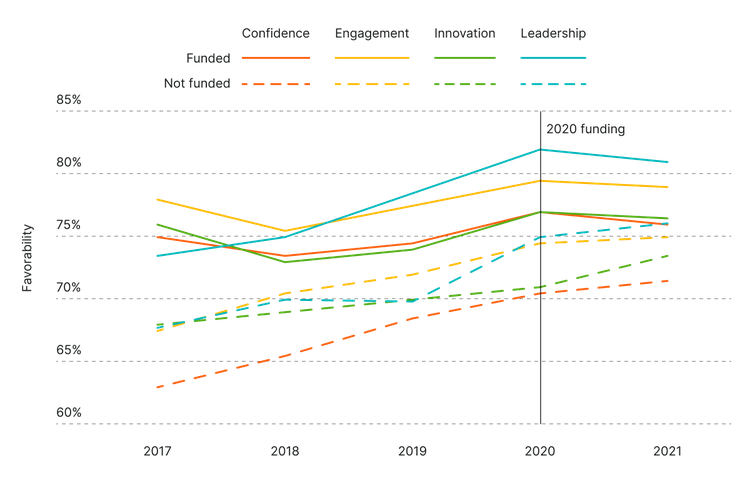
Article
For startups, it pays to invest in employee engagement, especially if your company is looking to raise a funding round. While there are many tangible variables that determine if a company receives funding, from product uniqueness to a proven track record of sales, intangible variables like company values and culture also influence a business’s ability to prove it’s set up for success. For example, a company that values innovation and creativity may be more likely to develop unique products and services for its customers.
In our Culture Crunch: Top trends throughout the company lifecycle report, we analyzed employee engagement survey results by company funding stage to better understand how culture impacts a company’s ability to attract outside investors. Based on our findings, here’s a closer look at the relationship between employee engagement and attracting funding for a business.
When a company is first founded, culture is created almost subconsciously. It’s common for founders to focus more on building a product or service that delights customers and less on the core values they want their employees to embody every day. That’s not a bad thing, early on. After all, when companies are just starting out, it’s often easier to feel the culture than to describe it.
But as companies grow and new employees are brought on, a strong cultural foundation becomes more important. At this stage, it helps to be more mindful of the values and expectations that guide your employees’ time at your company. A strong, positive work culture can keep employees grounded through times of change and hypergrowth, like a fundraising round, and help you move forward as a team.
Investing in company culture isn’t just good for your employees; it gives you a competitive edge when looking for funding. Digging into the numbers from our Culture Crunch: Top trends throughout the company lifecycle report, we found companies that received funding had higher culture and employee sentiment scores than companies that didn’t raise money. Higher levels of engagement are strongly associated with successful funding rounds. In fact, companies that receive funding have employees who are more engaged, are more confident in the business, believe in company leadership, and feel a culture of innovation.

But, what if these results were impacted by employees anticipating a funding round? To rule that possibility out, we compared the scores of companies that received funding and those that didn’t over the span of five years. We found that businesses that received funding displayed elevated levels of the four factors mentioned above as early as 3 years prior to their fundraising round. This positivity and optimism may reflect that employees believe in the company’s mission and potential for success.

According to our research, it isn’t that an injection of cash makes a company more innovative – it’s that a company culture that emphasizes innovation makes you more likely to receive funding. Of course, a funding round can boost employee confidence and engagement temporarily, but building a company culture that expands beyond your latest investment round is what will carry your business as it scales. While it’s important for your leaders to focus on securing funding for your business, don’t overlook the importance of investing in your employees and culture as these elements will determine your business’ success in the long run.
Now that we’ve established the strong relationship between employee engagement and a business’s ability to attract outside investors, it’s time to ensure your company is set up for success. Here are the main takeaways we pulled from this data to help you target your culture-creation efforts.
At early-stage companies with a small, flat organization, it’s easy to communicate with employees and make them feel involved in decision-making processes. As your business grows and hires more middle managers, a hierarchy will naturally form. This new hierarchal organization can be off-putting to long-time employees who’ve grown used to autonomy and transparency. You might even experience a drop in employee engagement and an increase in turnover. To help ease this transition and set your business up to continue to scale, hire and retain managers who care for and invest in their teams. Strong people leaders who listen to their teams and understand how to meet their wants and needs can make all the difference in shaping an exceptional day-to-day employee experience.
Innovation helps your business grow and scale, but it can only happen in the right environment. Give your employees the resources and autonomy to pursue their ideas. Encourage managers to be open-minded towards trying new things. Remind them that failure is not a disappointment, but rather a valuable learning experience. This approach contributes to a culture of innovation. With this type of company culture, your employees are more likely to create innovative products and services that help your business reach new audiences and delight your existing customers in new ways.
Throughout every stage of your business, your employees will have different wants and needs. For example, employees at a young, recently founded company might want autonomy and job security, while employees at a larger, more established company might crave organizational transparency and meaningful work. In order to build a better workplace, your business must always listen to your employees and take action based on their feedback.
If your employees are not confident in your company, your leadership, or your products, there’s probably a good reason. Pay close attention to employee perspectives and figure out what you can do to change them or make life at your company better for your team. Organizing ongoing employee engagement surveys is the easiest way to track changes in employee sentiment, take swift action on your findings, and measure the impact of your actions. By soliciting and acting on employee feedback, you can gradually improve culture and sentiment over time.
It’s worth prioritizing company culture from day one, not just right before a funding round. To help your team make better decisions around culture now and lay the foundation for future growth, we’ve created our Culture Crunch: Top trends throughout the company lifecycle report.
